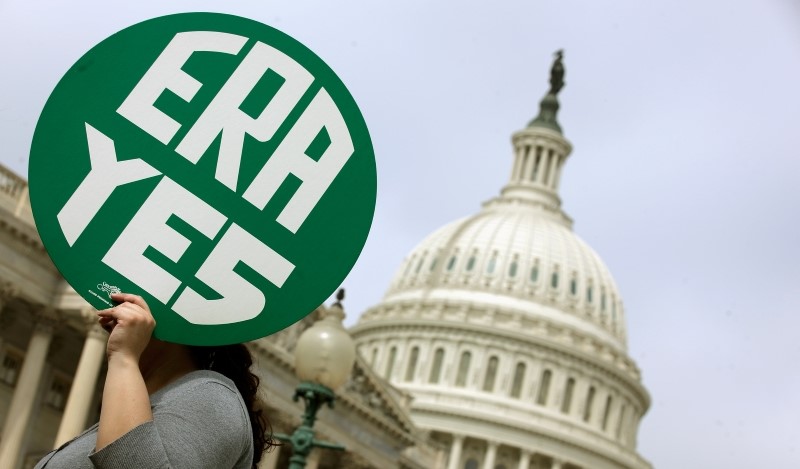
Experts consider obstacles to the ERA’s ratification and propose paths forward.
After U.S. states ratified the 19th Amendment granting women the right to vote in 1920, suffragists shifted their focus to the Equal Rights Amendment (ERA). Written by Alice Paul and Crystal Eastman in 1923, the ERA would provide Congress with the power to enforce sex-based equality as a constitutional right.
Opponents to the ERA have evolved over the past century. Conservative activist Phyllis Schlafly campaigned against the ERA in the 1970s, arguing that the ERA would take away women’s exemption from the military draft.
Carrie N. Baker of Smith College, however, explains that the ERA would not bar all distinctions based on sex. Women’s privacy and safety, for example, likely could be considered a compelling government objective to justify laws classifying individuals on the basis of sex.
There are two ways to amend the U.S. Constitution: two-thirds of both Houses of Congress may vote to approve it, or two-thirds of the states may request a convention. Then, either three-fourths of the state legislatures or three-fourths of each state’s conventions would have to ratify the amendment.
One challenge to passing the ERA is that the amendment’s proposing clause contains a seven-year time limit for its passage. Congress passed a bill signed by President Jimmy Carter in 1978 to extend the deadline for ratification to 1982. By the 1982 deadline, however, no new states had ratified the ERA since 1978. Now, Congress continues to introduce bills that would ratify the ERA as a valid constitutional amendment regardless of time limit.
The word “women” is not explicitly included anywhere in the Constitution. Some scholars, including Victoria Nourse of Georgetown Law, argue that the only solution to protect women’s rights from legislative and judicial attacks is for recognition of women in the text of the Constitution through the ERA. Even with significant progress for women’s rights and representation in American society, scholars including Nourse warn that originalist interpretations of the Constitution by some members of the U.S. Supreme Court threaten women’s equality.
Women also make up less than a fifth of senior leadership positions across all sectors, and policies that invoke unequal treatment among genders play a role in this, Rangita de Silva de Alwis of the University of Pennsylvania Carey Law School argues. New York Attorney General Letitia James explains that the ERA would provide a strict scrutiny standard for sex discrimination cases and strengthen women’s protections under Title IX, for instance.
In this week’s Saturday Seminar, scholars and practitioners explore the ERA’s potential impact on U.S. constitutional procedure and equality for women.
- The ERA would place sex-based discrimination cases in the highest level of judicial review, regardless of judicial attitudes, Kate Kelly and Isabela Salas-Betsch of the Center for American Progress discuss in a report. Justice Antonin Scalia, for instance, contended that the Constitution does not prohibit sex-based discrimination. Kelly and Salas-Betsch explain that the ERA reached the three-fourths threshold needed for passage after Virginia’s ratification in 2020. The Trump Administration argued that the deadline to ratify the ERA had passed and blocked the addition of the ERA to the Constitution, but a congressional joint resolution expresses that the ERA is enforceable as the 28th Amendment. Kelly and Salas-Betsch conclude the ERA should be adopted regardless of the path that ratification takes.
- In a recent article in the Georgetown Law Journal, Julie C. Suk of Fordham University School of Law celebrates the late Justice Ruth Bader Ginsburg’s lifelong commitment to the ERA, and Ginsburg’s concerns about the ERA’s viability in the legislative and judicial branches. Suk highlights Justice Ginsburg’s history as a scholarly expert on procedural fairness and points out that no other amendment has failed because of a procedural time bar. While Justice Ginsburg supported the message of the ERA, she reportedly stated “I’d like it to start over” at a public event in February 2020. Ultimately, Suk contends that while Justice Ginsburg’s support for the ERA was ambivalent, her passion for a healthy constitutional democracy and women’s equality was unquestionable.
- The United States is one of the only countries in the United Nations that does not explicitly prohibit discrimination or guarantee equal rights on the basis of sex or gender, explain Aleta Sprague, Jody Heymann, and Amy Raub of the WORLD Policy Analysis Center in an article in the Columbia Journal of Gender and Law. Sprague, Heymann, and Raub caution that sex-based discrimination only receives intermediate scrutiny by the judiciary and is not prohibited by the U.S. Constitution. They argue that the present resurgence of textualism puts at risk past precedent protecting gender equality under the law. Sprague, Heymann, and Raub contend that passing the ERA is an essential next step in ensuring that gender equality remains settled law.
- Over 100 years since the ERA was first introduced, and five years since the #MeToo Movement gained popularity and the need to codify the ERA is increasingly urgent, Ally Coll of George Mason University and practitioner Michelle Kallen argue in an article in the Harvard Law and Policy Review. Coll and Kallen explain that during the #MeToo movement, three states ratified the ERA, meeting the requisite three-fourths state majority. But critics of the ERA continue to block its ratification, and legislative ratification efforts remain unresolved, Coll and Kellen explain. Coll and Kellen emphasize the importance of ratifying the ERA to ensure that people of all genders are guaranteed equal protection under the law.
- In a Congressional Research Service report, Jon O. Shimabukuro discusses the constitutional uncertainties regarding the current state of the ERA. Shimabukuro explains that in Virginia v. Ferriero, three states brought suit to have the ERA certified and published. Shimabukuro notes, however, that the district court dismissed the suit on the basis that the states did not allege actual injury caused by refusal to publish the amendment. Shimabukuro further asserts that the appellate court dismissed the case because the states failed to establish the ability to compel publication. Because the states were unsuccessful at both levels, Shimabukuro suggests that restarting the ratification process might be the best way to avoid the constitutional uncertainties regarding the post-deadline ratifications and rescissions by states.
- In an article in the Columbia Journal of Gender and the Law, Kate Andrias of Columbia Law School emphasizes the necessity of passing the ERA given the Supreme Court’s recent decisions limiting the scope of equal protection. Current labor movements, Andrias explains, neglect women who do domestic work and caregiving for children and family members—a burden that disproportionately falls on poor women and women of color. Despite the importance of the ERA, Andrias acknowledges that ratification alone will not guarantee equal protection based on one’s sex. In addition to ratification, Andrias urges federal and state legislatures and social movements to fight for a broader interpretation of equal protection than the one currently employed by conservative Supreme Court Justices.



